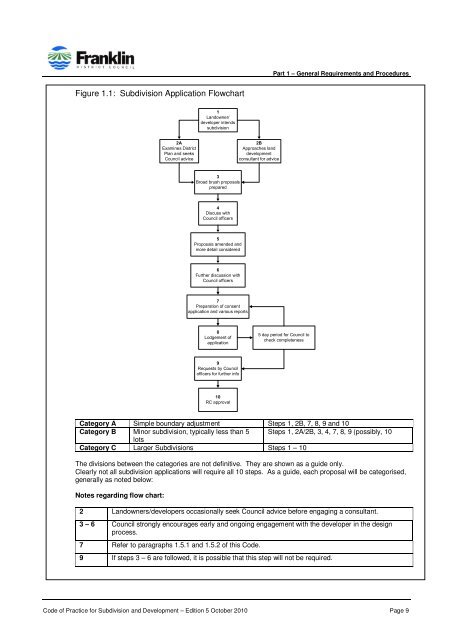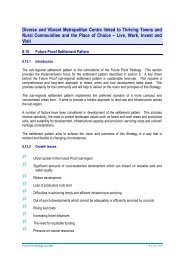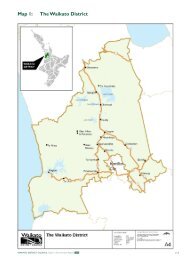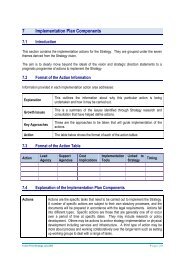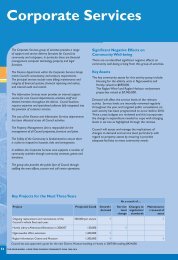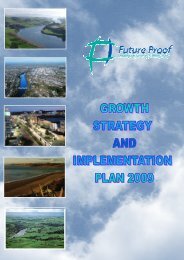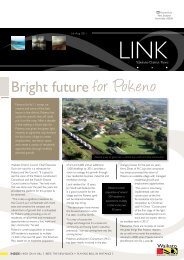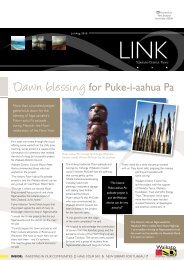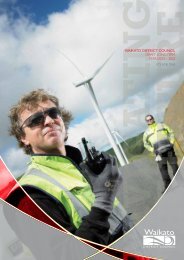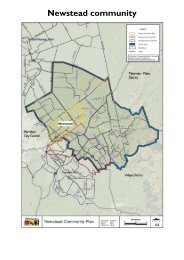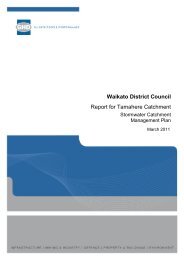- Page 1 and 2: CODE OF PRACTICEFORSUBDIVISION AND
- Page 3 and 4: Table of ContentsPART 1: GENERAL RE
- Page 5 and 6: Table of Contents3.3.11 Traffic Ser
- Page 7 and 8: Table of Contents7.2.2 Landscape Pl
- Page 9 and 10: Table of ContentsAPPENDICESAppendix
- Page 11 and 12: Part 1 - General Requirements and P
- Page 13 and 14: Part 1 - General Requirements and P
- Page 15 and 16: Part 1 - General Requirements and P
- Page 17: Part 1 - General Requirements and P
- Page 21 and 22: Part 1 - General Requirements and P
- Page 23 and 24: Part 1 - General Requirements and P
- Page 25 and 26: Part 1 - General Requirements and P
- Page 27 and 28: Part 1 - General Requirements and P
- Page 29 and 30: Part 2 - Earthworks and Foundations
- Page 31 and 32: Part 2 - Earthworks and Foundations
- Page 33 and 34: Part 2 - Earthworks and Foundations
- Page 35 and 36: Part 2 - Earthworks and Foundations
- Page 37 and 38: Part 2 - Earthworks and Foundations
- Page 39 and 40: Part 2 - Earthworks and Foundations
- Page 41 and 42: Part 3 - Roads3.2.2 ParkingFor matt
- Page 43 and 44: Part 3 - Roads3.2.4 Requirements fo
- Page 45 and 46: Part 3 - Roads3.2.9 Pedestrian and
- Page 47 and 48: Part 3 - Roads3.2.13 Standards and
- Page 49 and 50: Part 3 - Roadsaccordance with claus
- Page 51 and 52: Part 3 - RoadsThe requirements of t
- Page 53 and 54: Part 3 - Roads3.3.9 Crossfall on Gr
- Page 55 and 56: Part 3 - RoadsPercentage of Materia
- Page 57 and 58: Part 3 - RoadsPainted road markings
- Page 59 and 60: Part 3 - Roads3.3.16 Dished Channel
- Page 61 and 62: Part 3 - Roads(d)A double crossing
- Page 63 and 64: (j)(k)(l)Lighting should be conside
- Page 65 and 66: Part 4 - DrainageWhere subdivision
- Page 67 and 68: Part 4 - Drainage4.2.5 Design Flow
- Page 69 and 70:
Part 4 - Drainage4.2.7 The Hydrauli
- Page 71 and 72:
Part 4 - DrainageWhere the pipeline
- Page 73 and 74:
Part 4 - DrainageHydraulic flow in
- Page 75 and 76:
Part 4 - DrainageWhere an extended
- Page 77 and 78:
Part 4 - Drainage4.2.21 Acceptance
- Page 79 and 80:
Part 4 - DrainageManagement Plan De
- Page 81 and 82:
Part 5 - Waste WaterThe above desig
- Page 83 and 84:
Part 5 - Waste WaterJointsAll pipes
- Page 85 and 86:
Part 5 - Waste Waterand application
- Page 87 and 88:
Part 5 - Waste Water5.2.9 Ramped Ri
- Page 89 and 90:
Part 5 - Waste Water22. All control
- Page 91 and 92:
Part 6 - Water Supply and Other Ser
- Page 93 and 94:
Part 6 - Water Supply and Other Ser
- Page 95 and 96:
Part 6 - Water Supply and Other Ser
- Page 97 and 98:
Part 6 - Water Supply and Other Ser
- Page 99 and 100:
Part 6 - Water Supply and Other Ser
- Page 101 and 102:
Part 6 - Water Supply and Other Ser
- Page 103 and 104:
Part 7 - Parks and ReservesPART 7:
- Page 105 and 106:
Part 7 - Parks and ReservesTABLE 7.
- Page 107 and 108:
Part 7 - Parks and Reserves7.3.6 St
- Page 109 and 110:
Part 7 - Parks and ReservesShould s
- Page 111 and 112:
Part 7 - Parks and ReservesEngineer
- Page 113 and 114:
Part 7 - Parks and Reserves7.8 FERT
- Page 115 and 116:
Part 7 - Parks and ReservesShrubs s
- Page 117 and 118:
Part 7 - Parks and Reservescommence
- Page 119 and 120:
Part 7 - Parks and Reserves7.14.6 T
- Page 121 and 122:
Part 7 - Parks and Reserves• Main
- Page 123 and 124:
Part 7 - Parks and Reservessuitable
- Page 125 and 126:
Part 7 - Parks and Reservesand othe
- Page 127 and 128:
Part 7 - Parks and ReservesSpraying
- Page 129 and 130:
Part 7 - Parks and ReservesTABLE 7.
- Page 131 and 132:
Part 7 - Parks and ReservesITEM REG
- Page 133 and 134:
Part 8 - Power, Telephone and Gas8.
- Page 135 and 136:
Appendix AStatement of Professional
- Page 137 and 138:
Appendix BDesign Certificate - Land
- Page 139 and 140:
Appendix CCertified Development Che
- Page 141 and 142:
Appendix EElectronic As-Built Requi
- Page 143 and 144:
Appendix GStandard Detail Drawings


